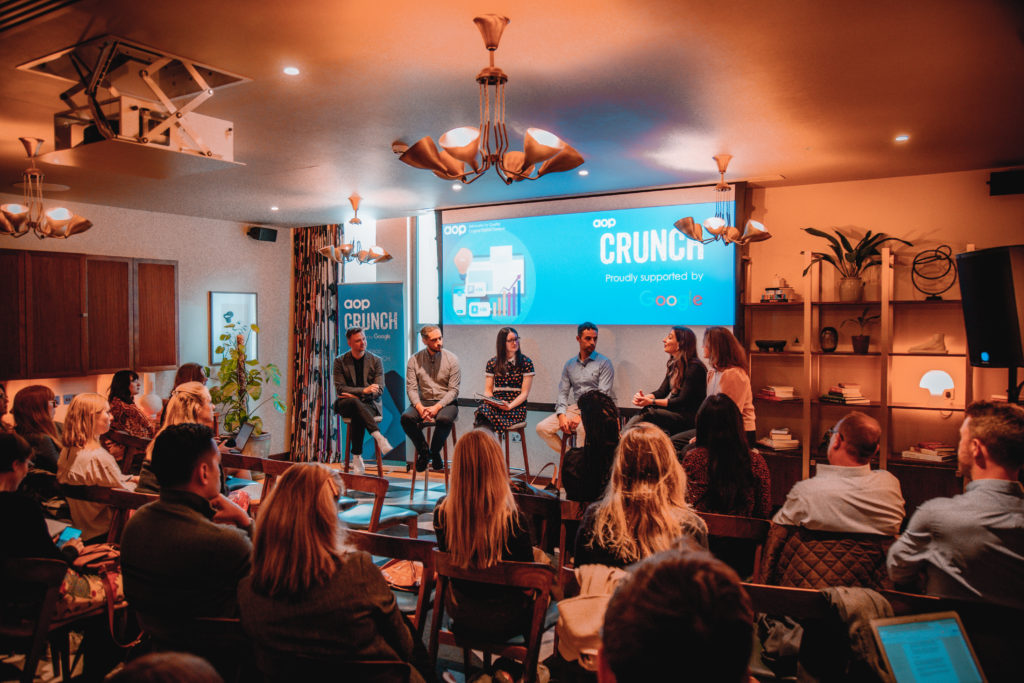|
Getting your Trinity Audio player ready...
|
At AOP’s first in-person CRUNCH event of 2022, Charlotte Tobitt, UK Editor at Press Gazette, spoke with a panel of industry experts about audiences: how to engage with them, how to turn that engagement into value, and how to prove that value to advertisers. With half of publishers now seeing opportunity in the post-cookie landscape, what can they do to make sure the grass is greener?
Engagement beats scale for driving both subs and ads
To create a resilient, future-proofed business model, publishers must consistently update their approaches to revenue in response to changing audience behaviours and trends. Take The Independent for example, which developed a method of aligning calls to action (CTA) with audience segments based upon their level of engagement, with the aim to boost site registrations by two million in twelve months.
To identify and appropriately target audience segments, Head of Consumer Marketing, Ross Wilmot and his team developed a bespoke engagement metric to sort site visitors into high, medium, and low engagement segments. A tailored call-to-action was then delivered to maximise conversions for that particular segment. For example, the high engagement segment — 350x more likely to convert than the lowest segment — received more direct prompts to contribute or subscribe, while medium engagers were given additional premium content previews. A test and learn approach refined these segments and CTAs over time.
“Our engagement segments are completely fluid, they update on a daily basis,” said Wilmot. “We’re not waiting for someone to churn, we’re spotting the signs early and then using the data to understand what levers we have to pull… suddenly we’re making content recommendations, newsletter recommendations, trying to get them back up through those engagement segments.”
The result was a 1,000% increase in monthly registration volume, sailing well past the original two million target.
Anthony Crocker, Head of Campaign Innovations at The Telegraph, also recently oversaw a period of transition in how engagement is valued, moving away from a focus on scale and click-through rates (CTR) towards a smaller, more engaged audience attracted to quality, not clickbait. This emphasis shift promised to drive more subscriptions for The Telegraph’s premium service, but could brands be convinced that scale is worth sacrificing?
To prove his case, Crocker needed metrics. Oracle measured the quality of editorial content while Brand Metrics tracked post-campaign exposure to demonstrate not merely whether an ad was clicked but whether there was meaningful interaction. Changes were made to ad positioning, too: one per screen in a predefined ad space with no distracting pop-ups so that attention was fixed on one ad at a time. Both the content and the ads were treated like a premium experience.
“The stronger [the audience’s] affinity towards the Telegraph brand was … the stronger their affinity towards the [advertiser] brand was; their recall levels were higher and the brand impact was much more positive,” said Crocker. “Think about Vogue. It’s a premium magazine … yet the first half of that magazine is advertising. But that’s fine, people enjoy that as part of their engagement experience because the ads are beautiful and relevant and fit into the values and identity of Vogue.”

Curated communities retain audiences and create value
Karien Stroucken, Director of Strategy and Partnerships at community platform Zapnito, reminded attendees of the early ambitions of the internet: a limitless space for sharing knowledge. But such ambitions have been diluted by the noise of an internet dominated by social media. Curated communities, on the other hand, provide a calmer signal-to-noise ratio where people can give and receive specialist knowledge without intrusion.
A curated community can provide more value to specialist audiences than content alone, and audiences are willing to pay to gain access. As the community grows, a positive feedback loop gains momentum: users contribute content, the community gains value, which brings in more users and more subscriptions. Eventually, the community becomes essential to the profession itself, which Stroucken likened to the virtual equivalent of traditional academic societies.
Research, educational and professional publisher, “Springer Nature, has been running expert communities with us for the last five years,” said Stroucken. “Their main aim is to create a larger connection with the organisation as well as brand loyalty, all to drive subscriptions. They found that being part of the community and participating in it has increased the likelihood of resubmitting an article to Springer Nature by 60%.”
To connect with its diverse, global, engaged community, Refinery29, from VICE Media Group, goes where its audience goes, whether that’s the Money Diaries group on Facebook, the Instagram-based R29 Style channel or connecting to the community of female gamers on Twitch. This has meant cultivating collaboration between departments so that the right content finds the right audience on the right platform and attracts the right brands.
“We feel we are on the forefront of representing the complexities of our audience and doing our best to listen to their needs and where they feel underserved, and being able to pull them into the storytelling so they feel seen and heard on our different platforms,” said Tamar Riley, VP of Audience and Content Strategy at VICE Media Group. “We’re choosing audience members who are not at the top of their macro-influencer game, it’s very much about celebrating the real audiences that are reading our site every single day.”
Opening audience data will help publishers get over cookies
No discussion of the current media landscape is complete without the demise of the third-party cookie. Lawyer-turned-marketer, self-professed privacy nerd and CEO of ID Ward Mattia Fosci recommended that publishers should not wait for a replacement for cookies, but should take control of their audience data and even collaborate with their competitors.
“If publishers just wait for a tech vendor or for agencies to solve this problem, they might or they might not. And if they do solve this problem, they might not solve it in a way that is in your favour — because the cookie wasn’t,” said Fosci. “It’s important that the leading publishers who have the resources and understanding … are active with a strategic mindset as well.”
Fosci sees beautiful potential in a “web of open gardens”, where publishers directly share anonymised first party data with other publishers and advertisers, while cutting down on the use of intermediaries. Publishers would retain 100% of their audience data without compromising on scale, while advertisers would be provided an 100% match rate for cross-domain identification and retargeting. Moving to a web of open gardens would not simply be a matter of changing technology, it would be a broad cultural and systemic change.
Data was devalued by its ubiquity, but current and upcoming privacy regulations will force publishers to do more with less. By refocusing attention on their own audiences and the insights their data reveals, publishers can create value for readers, content creators, and advertisers.
Richard Reeves
Managing Director, AOP
The UK Association for Online Publishing (AOP) is an industry body representing digital publishing companies that create original, branded, quality content. AOP champions the interests of media owners from diverse backgrounds including newspaper and magazine publishing, TV and radio broadcasting, and pure online media.



